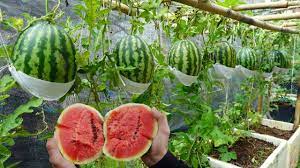Cultivating watermelons in containers is a fun and rewarding way to enjoy this juicy fruit, even if you have limited space. With the right approach, you can successfully grow watermelons at home. Here’s an in-depth guide to help you get started:
1. Choosing the Right Container
- Size Matters: Use a container with at least 20 gallons of capacity to provide ample space for the watermelon’s expansive roots.
- Depth Requirements: Opt for a depth of 24 inches or more to support the plant’s long root system.
- Drainage is Key: Ensure the container has multiple drainage holes to prevent waterlogging, which can lead to root rot.
2. Selecting the Best Watermelon Variety
- Compact Varieties: Choose small or bush types like ‘Sugar Baby’ or ‘Bush Sugar Baby,’ which are ideal for container gardening due to their manageable size.
- Space Efficiency: If you’re working with limited space, opt for varieties specifically bred for smaller areas.

3. Preparing the Soil and Planting
- Soil Mix: Use a nutrient-rich, well-draining potting mix. Adding compost or aged manure can boost nutrient levels, ensuring healthy plant growth.
- Planting Seeds: Sow 2-3 seeds about 1 inch deep in the container’s center. Once they sprout, thin them down to the strongest seedling.
- Spacing: If using multiple containers, maintain at least 2 feet between each for optimal air circulation and sunlight exposure.
4. Providing Water and Sunlight
- Consistent Watering: Water deeply, ensuring the soil remains consistently moist but not soggy. Allow the top layer of soil to dry slightly between waterings.
- Sunlight Requirements: Place the container in a sunny location that gets 8-10 hours of direct sunlight daily to support vigorous growth and fruit production.
5. Supporting and Maintaining the Plant
- Trellis or Support: Install a sturdy trellis or frame for the vines to climb, improving air circulation and reducing the risk of pests and diseases.
- Fertilization: Feed the plant with a balanced, slow-release fertilizer or a half-strength water-soluble fertilizer every 4 weeks.
- Pruning: Trim excess vines and leaves regularly to focus the plant’s energy on developing fruits.
6. Managing Pests and Diseases
- Pest Control: Watch for aphids and spider mites. Use organic solutions like neem oil or insecticidal soap to keep infestations at bay.
- Disease Prevention: Prevent fungal issues like powdery mildew by ensuring adequate spacing and air circulation. Apply eco-friendly fungicides if necessary.
7. Harvesting Your Watermelons
- Maturity Timeline: Most watermelons mature within 80-100 days, depending on the variety.
- Ripeness Indicators: A ripe watermelon will sound dull when tapped and have a yellowish patch on the underside where it rests.
- Harvesting Technique: Use garden shears to cut the fruit from the vine, leaving about 2 inches of stem attached.
Final Thoughts
Growing watermelons in containers is both a challenge and a delight. It requires attention to detail, but the rewards of harvesting your home-grown, juicy watermelons are well worth the effort. With the right care, each season brings not only delicious fruit but also valuable gardening experience.
Enjoy the process, embrace the learning, and savor the sweet fruits of your labor!
